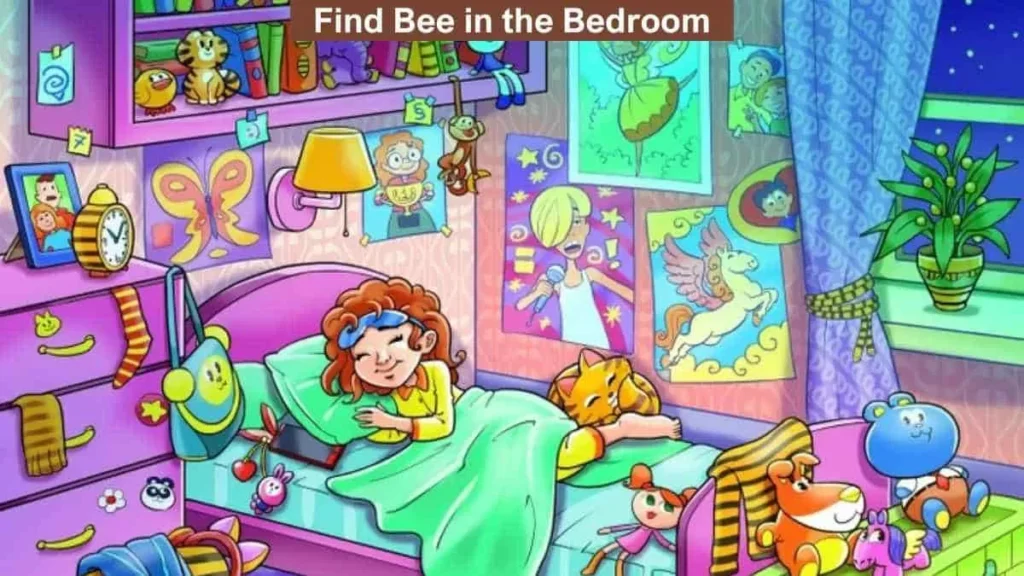Optical illusions have long intrigued and fascinated humanity, challenging our perception and understanding of reality.
These captivating phenomena can trick our minds into seeing things that aren’t there or perceiving reality in ways that defy logic.
Among the myriad optical illusions that have perplexed us, the “Bee Spotting Eye Test” stands out as a particularly engaging and entertaining example.
In this article, we delve into the world of optical illusions, exploring what they are, how they work, and why the Bee Spotting Eye Test has garnered attention as both a fun diversion and a fascinating psychological phenomenon.
Join us on this journey as we uncover the secrets behind this intriguing visual puzzle.
Understanding Optical Illusions:

Before delving into the specifics of the Bee Spotting Eye Test, it’s essential to grasp the fundamentals of optical illusions.
At their core, optical illusions exploit the intricate workings of the human visual system, leveraging principles of perception, contrast, and cognitive biases to create misleading images or sensations.
One of the key concepts underlying optical illusions is the notion of ambiguity.
Our brains constantly strive to make sense of the visual information they receive, often relying on shortcuts and heuristics to interpret complex scenes quickly.
However, these shortcuts can sometimes lead to errors in perception, especially when faced with stimuli that challenge our preconceived notions of reality.
Another crucial factor in optical illusions is contrast.
By manipulating contrast levels between different elements of an image, illusionists can draw attention to specific features or distort our perception of size, shape, or color.
This manipulation of contrast is a powerful tool in creating visual illusions that defy our expectations.
The Bee Spotting Eye Test:
Now, let’s turn our attention to the Bee Spotting Eye Test, a deceptively simple yet engaging optical illusion that has captivated countless individuals around the world.
The premise of the test is straightforward: viewers are presented with an image containing a seemingly ordinary scene, such as a field of flowers, and are challenged to spot a hidden bee within a specified timeframe, typically 10 seconds.
What makes the Bee Spotting Eye Test so intriguing is its ability to confound our expectations and challenge our perception.
At first glance, the image appears to be nothing more than a colorful tableau of flowers and foliage.
However, upon closer inspection, a small bee hidden amidst the floral landscape emerges, often blending seamlessly into the background.
The success of the Bee Spotting Eye Test hinges on several factors, including the strategic placement of the bee within the image, the use of subtle cues to guide the viewer’s gaze, and the element of surprise inherent in discovering the hidden creature.
By skillfully manipulating these elements, creators of the test can craft visually compelling illusions that captivate and challenge participants in equal measure.
Psychological Insights:
Beyond its entertainment value, the Bee Spotting Eye Test offers valuable insights into the workings of the human mind and perception.
One of the key phenomena at play is known as inattentional blindness, wherein individuals fail to notice unexpected objects or stimuli in their field of vision due to a lack of attention or focus.
In the context of the Bee Spotting Eye Test, participants may initially overlook the hidden bee due to the overwhelming visual complexity of the scene or a lack of expectation regarding its presence.
However, once their attention is directed towards the task of spotting the bee, they may experience a moment of revelation as the hidden creature suddenly emerges from the background.
Furthermore, the Bee Spotting Eye Test highlights the importance of context and expectation in shaping our perception of visual stimuli.
By priming participants to search for a specific object within the image, creators of the test can influence how individuals interpret and process the scene, leading to variations in performance and success rates.
Practical Applications:
While the Bee Spotting Eye Test primarily serves as a source of entertainment and amusement, its underlying principles have practical applications in various fields, including psychology, marketing, and design.
By understanding how optical illusions influence perception and cognition, researchers and practitioners can leverage these insights to enhance communication, design more effective visual materials, and even develop novel approaches to cognitive testing and assessment.
For example, marketers may employ principles of optical illusions to create attention-grabbing advertisements or packaging designs that stand out in a crowded marketplace.
Similarly, educators and trainers could incorporate visual puzzles and challenges, such as the Bee Spotting Eye Test, into learning activities to engage students and promote critical thinking skills.
Conclusion:
The Bee Spotting Eye Test offers a fascinating glimpse into the world of optical illusions, demonstrating the power of perception to shape our understanding of reality.
By leveraging principles of contrast, ambiguity, and inattentional blindness, creators of the test have crafted a captivating visual puzzle that challenges and delights participants in equal measure.
As we continue to unravel the mysteries of optical illusions, we gain valuable insights into the workings of the human mind and the intricate interplay between perception and cognition.
Whether as a source of entertainment, a tool for education, or a springboard for scientific inquiry, optical illusions such as the Bee Spotting Eye Test remind us of the endless possibilities inherent in the world of visual perception.
So, the next time you encounter a seemingly ordinary scene, take a closer look—you never know what hidden wonders may await your discovery.